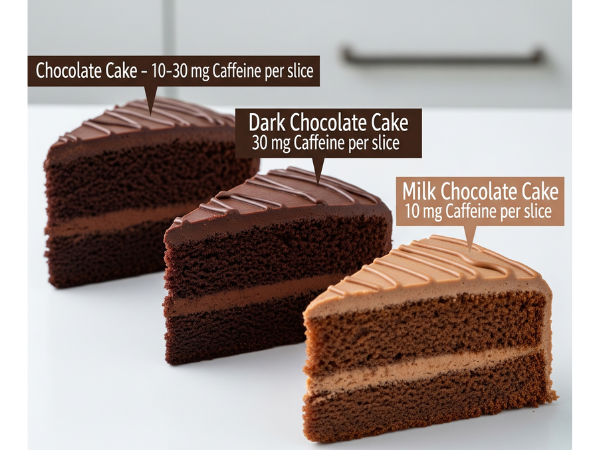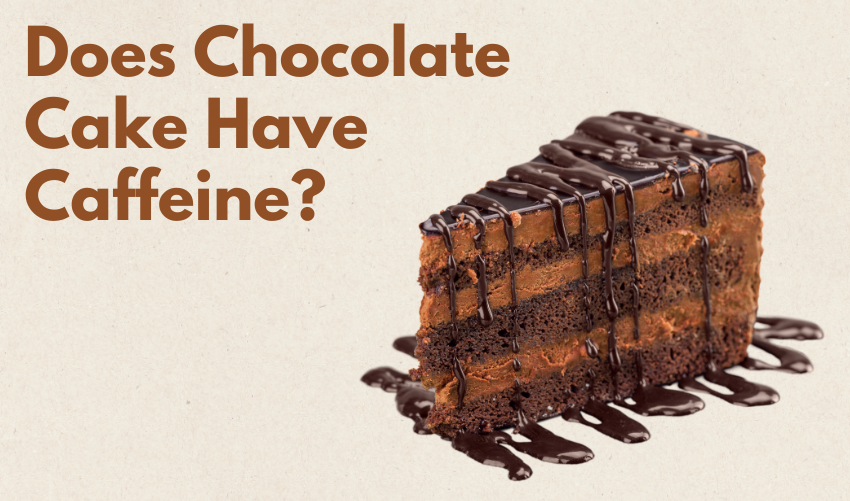Understanding whether your favorite dessert contains caffeine can help you make better choices, especially if you’re sensitive to it or trying to cut back.
We’ll dive into the facts about caffeine in chocolate cake. You’ll learn how much caffeine is typically found in different types of chocolate and how it varies based on the cake recipe.
Why Chocolate Cake Contains Caffeine
Chocolate cake is a beloved dessert, but many wonder: does it contain caffeine? The answer is yes, and it largely depends on the ingredients used.
The key player in this scenario is cocoa, the main ingredient that provides the chocolate flavor and caffeine content. Let’s explore the sources and variations that affect the caffeine levels in chocolate cake.
Cocoa Is The Source
Cocoa is the main source of caffeine in chocolate cake. Natural cocoa contains caffeine, about 12 mg per tablespoon of unsweetened cocoa powder. This amount can vary depending on the type of cocoa used. Here are some important points:
- Darker chocolate has more caffeine.
- Dark chocolate can have 20–30 mg per ounce.
- Unsweetened cocoa powder is a common ingredient in many chocolate cakes.
The caffeine content in cocoa is relatively low compared to coffee. However, it can still affect those who are sensitive to caffeine. A typical chocolate cake may contain several tablespoons of cocoa powder, leading to a cumulative effect. For example:
| Cocoa Type | Caffeine Content (mg per serving) |
|---|---|
| Natural Cocoa | 12 mg per tablespoon |
| Dark Chocolate | 20–30 mg per ounce |
So, the next time you enjoy a slice of chocolate cake, remember that cocoa is the source of its caffeine content.
Ingredient Variations Matter
The caffeine content in chocolate cake can vary greatly depending on the ingredients used. Cakes made with dark chocolate or espresso powder have higher caffeine levels. In contrast, milk chocolate or white chocolate versions contain less or even none.
- Dark Chocolate: Rich in flavor and caffeine.
- Milk Chocolate: Contains less caffeine.
- White Chocolate: Usually caffeine-free.
- Espresso Powder: Adds significant caffeine to the cake.
When baking or choosing a chocolate cake, pay attention to the type of chocolate used. If you are sensitive to caffeine, opt for cakes with milk chocolate or no chocolate at all.
How Much Caffeine Is In A Slice Of Chocolate Cake?
It can be surprising to learn how much caffeine is in a slice of chocolate cake. Understanding this can help you decide if you want a slice with your afternoon coffee.

Caffeine By Cake Type
The caffeine content in chocolate cake varies. The main factor is the type of chocolate used in the recipe. Here’s a breakdown of caffeine levels:
| Type of Cake | Caffeine Content (mg per slice) |
|---|---|
| Chocolate Cake | 10–30 mg |
| Dark Chocolate Cake | Higher end (up to 30 mg) |
| Milk Chocolate Cake | Lower end (around 10 mg) |
As you can see, dark chocolate cakes tend to be on the higher end of the caffeine scale. A slice of regular chocolate cake has about 10 to 30 mg of caffeine. This is much less than a cup of coffee, which has around 95 mg.
- Chocolate cake: 10–30 mg per slice (varies by recipe)
- Dark chocolate cakes tend to have more caffeine
- Less than a cup of coffee (~95 mg)
- Similar to a small piece of dark chocolate or a can of cola
Compare With Other Foods
When considering caffeine in chocolate cake, it helps to compare it with other foods. Here are some common items and their caffeine content:
| Food/Drink | Caffeine Content (mg) |
|---|---|
| Coffee (8 oz) | 95 mg |
| Dark Chocolate (1 oz) | 20-30 mg |
| Cola (12 oz can) | 30-40 mg |
| Chocolate Cake (slice) | 10-30 mg |
Chocolate cake has less caffeine than coffee. It can be similar to a small piece of dark chocolate or a can of cola. This makes chocolate cake a great treat for chocolate lovers who want a mild caffeine boost.
Navigating Chocolate Cake Consumption: Tips For Caffeine-sensitive Individuals
Chocolate does contain caffeine, and the amount can vary based on the type and quantity used. This can affect those sensitive to caffeine.
Moderation Is Key: Enjoying Without Overdoing
For caffeine-sensitive individuals, moderation is crucial. Here are some tips to help enjoy chocolate cake without overdoing it:
- Smaller slices or less intensely chocolatey cakes can reduce caffeine intake.
- Consider consuming chocolate cake earlier in the day if caffeine affects your sleep.
- Balance chocolate cake with other food items to lessen its impact.
Understanding portion control is essential. Here’s a simple table showing caffeine content in different types of chocolate cake:
| Type of Cake | Caffeine Content (mg per slice) |
|---|---|
| Dark Chocolate Cake | 30-50 mg |
| Milk Chocolate Cake | 10-20 mg |
| White Chocolate Cake | 0 mg |
Choosing lighter chocolate cakes can help manage caffeine intake. Always listen to your body. If you feel jittery, cut back on portions.
Opting For Lower Caffeine Options
There are many ways to enjoy chocolate cake while keeping caffeine low. Here are some effective strategies:
- Choose milk chocolate-based cakes over dark chocolate variations.
- Look for recipes that use less cocoa powder or chocolate chips.
- White chocolate cake is a caffeine-free alternative.
Making these simple changes can help control caffeine levels. Here’s a quick list of lower-caffeine options:
- Milk chocolate cake
- Chocolate cupcakes with less chocolate
- Chocolate mousse made with milk chocolate
Enjoying chocolate cake doesn’t have to mean high caffeine. With smart choices, it’s easy to satisfy your sweet tooth without the caffeine worries.
